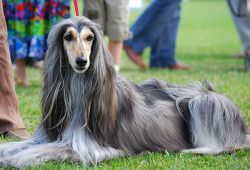The Afghan Hound is a hound that is distinguished by its thick, fine, silky coat and its tail with a ring curl at the end. The breed was selectively bred for its unique features in the cold mountains of [wiki base=”EN”]Afghanistan[/wiki]. Its local name is Tāžī Spay or Sag-e Tāzī. Other names for this breed are Kuchi Hound, Tāzī, Balkh Hound, Baluchi Hound, Barakzai Hound, Shalgar Hound, Kabul Hound, Galanday Hound or sometimes incorrectly African Hound.
Description
The Afghan Hound is tall, standing in height 61–74 cm (24–29 in) and weighing 20–27 kg (44–60 lb). The coat may be any colour, but white markings, particularly on the head, are discouraged; many individuals have a black facial mask. A specimen may have facial hair that looks like a Fu Manchu mustache. The mustache is called “mandarins”. Some Afghan Hounds are almost white, but parti-color hounds (white with islands of red or black) are penalized in the AKC standard, but not by the FCI. The long, fine-textured coat requires considerable care and grooming. The long topknot and the shorter-haired saddle on the back of the dog are distinctive features of the Afghan Hound coat. The high hipbones and unique small ring on the end of the tail are also characteristics of the breed.
The temperament of the typical Afghan Hound can be aloof and dignified, but happy and clownish when it’s playing. This breed, as is the case with many sighthounds, has a high prey drive and may not get along with small animals. The Afghan Hound can be a successful competitor in dog agility trials as well as an intuitive therapy dog and companion. Genomic studies have pointed to the Afghan Hound as one of the oldest of dog breeds.
Health
Lifespan
Afghan Hounds in UK surveys had an average lifespan of about 12 years. which is similar to other breeds of their size. In the 2004 UK Kennel Club survey, the most common causes of death were cancer (31%), old age (20%), cardiac (10.5%), and urologic (5%). Those that die of old age had a median lifespan of 12 years, with 12% living to at least 14.
Health concerns
Major health issues are allergies, cancer, and [wiki title=”Hip_dysplasia_(canine)” base=”EN”]hip dysplasia[/wiki]. Sensitivity to anesthesia is an issue the Afghan hound shares with the rest of the sighthound group, as sighthounds have relatively low levels of body fat. Afghan hounds are also among the dog breeds most likely to develop [wiki title=”Chylothorax” base=”EN”]chylothorax[/wiki], a rare condition which causes the thoracic ducts to leak, allowing large quantities of chyle fluid to enter the dog’s chest cavity. This condition commonly results in a lung torsion (in which the dog’s lung twists within the chest cavity, requiring emergency surgery), due to the breed’s typically deep, “barrel”-shaped chest. If not corrected through surgery, chylothorax can ultimately cause fibrosing pleuritis, or a hardening of the organs, due to scar tissue forming around the organs to protect them from the chyle fluid. Chylothorax is not necessarily, but often, fatal.
Afghan Hound. (2017, August 28). In Wikipedia, The Free Encyclopedia. Retrieved from https://en.wikipedia.org/w/index.php?title=Afghan_Hound&oldid=797641354


